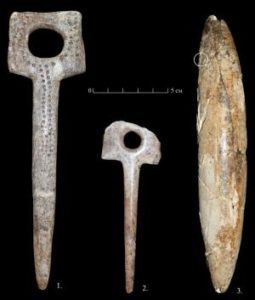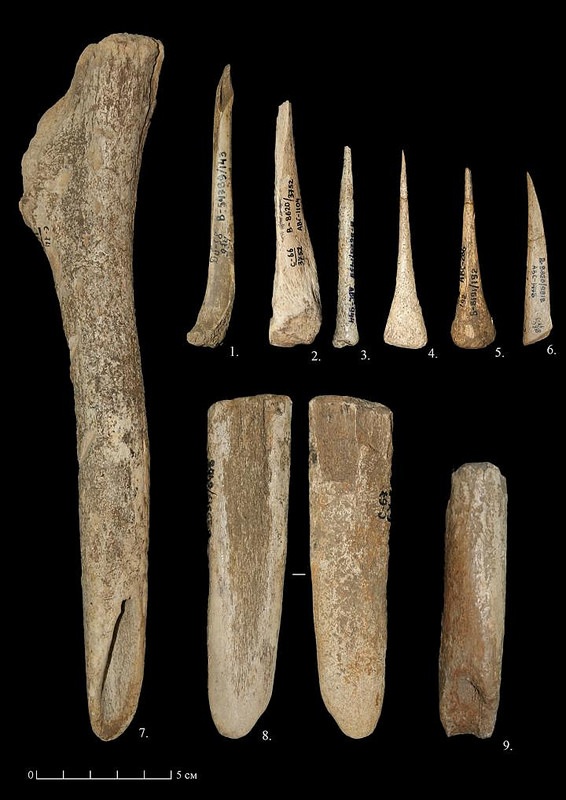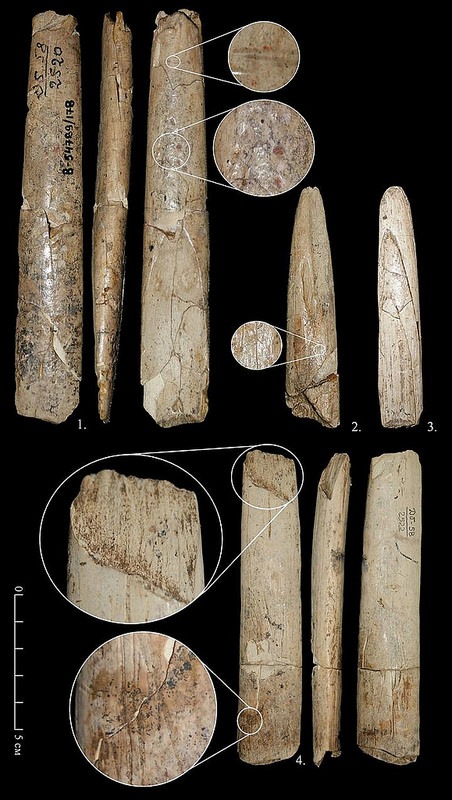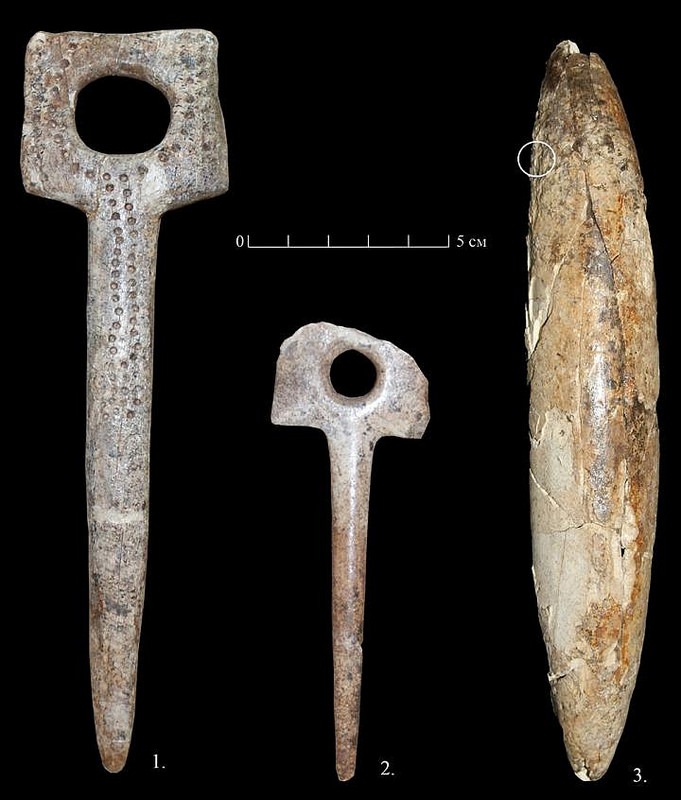
LOMONOSOV MOSCOW STATE UNIVERSITY—Archaeologists from the Lomonosov Moscow State University studied artifacts made of bone, antler and ivory excavated at the Sungir archaeological site. Through the study, they determined how Homo sapiens occupying the site processed solid organic materials and produced tools and ornaments. The study was published in a specialized digest produced by the Hugo Obermaier Society for Quaternary Research and Archaeology of the Stone Age.
The work has established that Sungir was a base camp for Paleolithic hunter-gatherers. One of the study authors, Taisiya Soldatova (Ph.D., Faculty of Foreign Languages and Regional Studies, MSU), also reports that further study of the objects may help to determine the place of the site in relation to the Upper Paleolithic of Europe.
The open-air Upper Paleolithic site is located near Vladimir city, 200 kilometers east of Moscow. It was discovered in 1955 during preparation work for construction of a plant, and investigated by an expedition under the leadership of the famous Soviet archaeologist Otto N. Bader. There he and his team uncovered a complex funerary complex, consisting of two graves, each containing two burials. The burials were accompanied by a rich inventory of objects, including a profusion of products made of ivory, such as beads, bracelets, and spears.
Radiocarbon analysis of fossils and other biological materials found at the site suggested a date range between 28,800 ± 240 and 25,500 ± 200 BP, but other data suggests the site is about 30 thousand years old.
During the collaborative work, Taisiya Soldatova conducted a study of 171 specimens of bone, antler and ivory (including working and hunting tools, blanks for various purposes and waste materials), while Vladislav Zhitenev (Ph.D., Associate Professor of Historical Archaeology, on the faculty of Moscow State University) focused his attention on the ornaments: pendants made of arctic fox teeth and beads of ivory.
“The main objective of the study is to examine the products made of solid organic materials (bone, antler and ivory) from the Sungir Upper Paleolithic site. Together with stone tools, working bone is an important indicator of cultural attribution, and can also play a significant role in addressing some of the relative chronology issues”, says Taisiya Soldatova.
Technological analysis of the Upper Paleolithic sites of the Vladimir region have shown that the Sungirian occupants had mastered a wide range of techniques for processing bone material—longitudinal and transverse fracture, transverse breaks with preparatory sawing, cutting, sawing, planing/scraping. All of these techniques have been used to create collections of bones, antler and ivory, so it is possible to determine a uniform treatment of solid organic materials by the Sungirian occupants.
On the other hand, the study showed that there are some differences between bone- and antler-working and the ivory industry: ivory tools and ornaments are better formed than bone and antler. Moreover, no ivory tools were used in household activity: only hunting weapons, art objects and ornaments. The collection, however, also contains three items of ivory that can be interpreted as tools: a “retoucher” and two “shaft straighteners”, though it should be emphasized that these instruments of ivory were found in burials and may thus have a symbolic meaning.
_________________________________________
Bone industry of the Sungir site: 1-5. Credit: Taisiya Soldatova
______________________________________________________
The instruments of hunting: 1, 3 – points; 2, 4 -blanks forpoint. Credit:Taisiya Soldatova
_____________________________________________________
Ivory tools from the Sungir burials: 1,2 – “shaft straighteners”; 3 – “retoucher”. Credit:Taisiya Soldatova
_______________________________________________________
The peculiarities of ivory processing found at the site have allowed the researchers to draw some parallels between Sungir and early Aurignacian sites (European Upper Paleolithic culture), from the raw material that served as ornaments and small figurines, and, in rare cases – a point with a massive base. Thus, it can be assumed that the bone industry of Sungir was culturally influenced by the early Aurignacian, resulting in similar categories of tools, as well as the nature of the ivory material use. Also found at Sungir was a high percentage of objects from antler (16%), similar to sites of the Upper Paleolithic found in Central and Western Europe.
Among the investigated items are finds of varying completion – from blanks to finished products. Therefore, the researchers suggest that the treatment of bone material happened at the site. In addition, the functional variety of the findings indicates that Sungir, covering an area of over 4,000 km2, showed a diversity of economic activity: The manufacturing of clothing from animal skins was confirmed by awls and pins; and hoe-like tools for excavation. Archaeologists also found chisels and points – meaning that the Sungir people paid attention to productive activities as well as hunting – particularly deer, mammoths, wolves and wild horses. In other words, Sungir was probably a prehstoric base camp, as opposed to the site discovered near Rusanikha, 8 km away from the study area. The head of the Rusanikha excavations – L.A. Mikhailova – suggests that the site was an encampement of mammoth hunters because of the predominance of stone hunting tools and animal bones.
“Comparing bones, antler and ivory objects from Sungir with European collections of the Early Upper Paleolithic sites can help identify the cause of differences in methods of treating various bone material, and finding the similarities may help define common features in the nature of bone industries of this age and determine the place of the researched site in the Upper Paleolithic of Europe”, Soldatova explains.
Source: Edited and adapted from a Lomonosov Moscow State University subject news release.
_______________________________________________________

______________________________________________
Travel and learn with Far Horizons.
____________________________________________
This richly illustrated issue includes the following stories: Recent findings shedding new light on the whereabouts of the remains of Philip of Macedon, father of Alexander the Great; how an archaeologist-sculptor is bringing bones of the dead back to life; archaeologists uncovering town life at the dawn of civilization; an exclusive interview with internationally acclaimed archaeologist James M. Adovasio about what makes the Meadowcroft Rockshelter prominent in the ongoing search for the first Americans; what archaeologists are finding at the site of the ancient city of Gath, the home town of the biblical Philistine giant, Goliath; and how scientists are redrawing the picture of human evolution in Europe. Find it on Amazon.com.










